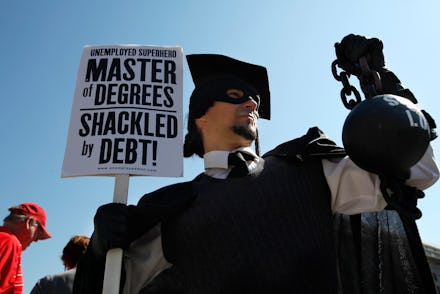Our Student Loan Debt in 3 Staggering Charts

Yesterday, the Federal Reserve Bank of New York released its quarterly report on credit and debt, and its striking graphs made one thing glaringly clear: While household debt has gone down overall, student loan debt and defaults are skyrocketing as millennials become lifelong thralls to their student loan providers.
Here's what their report had to say.
1. For the first time in history, student loan delinquencies have surpassed credit card delinquencies.
See that little red line that's reaching for the sky like some kind of orbital launch rocket? That's your problem right there. While previous generations might have fretted about their post-collegiate spending, millennials are entering adulthood already well in arrears. The next time someone tells you that millennials are profligate, irresponsible, or overly focused on instant gratification, you should point to that little red line, and tell them where to put it.
Delinquency on all other forms of debt has steadily decreased throughout the economy's recovery from the mortgage crisis (See, for instance, the mustard-colored mortgage line, or the navy blue credit card line). In contrast, student loan delinquency went from steadily increasing to shooting up precipitously at the beginning of 2012.
And according to the Fed report, it's still rising. The number of delinquent student loans increased by almost 10% in the last quarter alone, condemning a generation of young people to wage garnishment, lost Social Security payments, and seized tax refunds, despite recent efforts to ease repayment and combat banks' shady lending practices.
2. Student loan debt has surpassed all other forms of non-housing debt.
A second chart from the report highlights just how much student loans have grown compared to other forms of non-housing debt. It's almost as if banks had shifted away from mortgages and created a student loan bubble so large that even JP Morgan Chase is wary of its consequences.
Although credit card and auto loan debt fell after 2008, student loan debt (in red) has grown every quarter for the past decade — from 0.26 trillion to 1.03 trillion, a near-400% increase. As you can see, the wedge representing outstanding student loans is not just outpacing its peers, but slowly filling up the diagram like some kind of relentless debt kudzu.
While young people are increasingly pressured to pursue undergraduate and even graduate degrees as a prerequisite for entering the workforce, they're being charged far more than their parents for the privilege. Usurious private loans have come to fill the gap between federal aid and today's tuition rates, which have increased 1200% since 1978 for a four-year degree. These charts are the result.
3. Debt is down overall, but that's not necessarily something to celebrate.
A final chart showing overall debt in the United States peaking in 2008 and decreasing until today is good news, but a cold comfort. The economy may be recovering as a whole, but it appears to be doing so on the back of young people.
In fact, rather than representing recovery, future decreases in mortgages and credit card debt may point toward millennials' reluctance to purchase homes or run up a tab even as they age, as their paychecks head toward their student loans for decades to come.